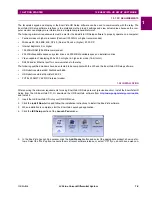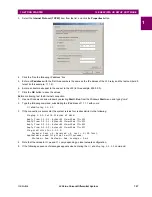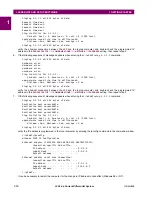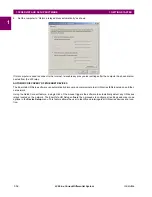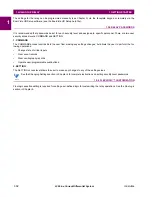
GE Multilin
L30 Line Current Differential System
1-3
1 GETTING STARTED
1.2 UR OVERVIEW
1
1.2.2 HARDWARE ARCHITECTURE
a) UR BASIC DESIGN
The UR is a digital-based device containing a central processing unit (CPU) that handles multiple types of input and output
signals. The UR device can communicate over a local area network (LAN) with an operator interface, a programming
device, or another UR device.
Figure 1–2: UR CONCEPT BLOCK DIAGRAM
The
CPU module
contains firmware that provides protection elements in the form of logic algorithms, as well as program-
mable logic gates, timers, and latches for control features.
Input elements
accept a variety of analog or digital signals from the field. The UR isolates and converts these signals into
logic signals used by the relay.
Output elements
convert and isolate the logic signals generated by the relay into digital or analog signals that can be used
to control field devices.
b) UR SIGNAL TYPES
The
contact inputs and outputs
are digital signals associated with connections to hard-wired contacts. Both ‘wet’ and ‘dry’
contacts are supported.
The
virtual inputs and outputs
are digital signals associated with UR-series internal logic signals. Virtual inputs include
signals generated by the local user interface. The virtual outputs are outputs of FlexLogic™ equations used to customize
the device. Virtual outputs can also serve as virtual inputs to FlexLogic equations.
The
analog inputs and outputs
are signals that are associated with transducers, such as Resistance Temperature Detec-
tors (RTDs).
The
CT and VT inputs
refer to analog current transformer and voltage transformer signals used to monitor AC power lines.
The UR-series relays support 1 A and 5 A CTs.
The
remote inputs and outputs
provide a means of sharing digital point state information between remote UR-series
devices. The remote outputs interface to the remote inputs of other UR-series devices. Remote outputs are FlexLogic oper-
ands inserted into IEC 61850 GSSE and GOOSE messages.
The
direct inputs and outputs
provide a means of sharing digital point states between a number of UR-series IEDs over a
dedicated fiber (single or multimode), RS422, or G.703 interface. No switching equipment is required as the IEDs are con-
nected directly in a ring or redundant (dual) ring configuration. This feature is optimized for speed and intended for pilot-
aided schemes, distributed logic applications, or the extension of the input/output capabilities of a single relay chassis.
Summary of Contents for L30
Page 10: ...x L30 Line Current Differential System GE Multilin TABLE OF CONTENTS ...
Page 30: ...1 20 L30 Line Current Differential System GE Multilin 1 5 USING THE RELAY 1 GETTING STARTED 1 ...
Page 370: ...5 244 L30 Line Current Differential System GE Multilin 5 10 TESTING 5 SETTINGS 5 ...
Page 464: ...A 10 L30 Line Current Differential System GE Multilin A 1 PARAMETER LISTS APPENDIX A A ...
Page 600: ...C 30 L30 Line Current Differential System GE Multilin C 7 LOGICAL NODES APPENDIX C C ...
Page 610: ...D 10 L30 Line Current Differential System GE Multilin D 1 IEC 60870 5 104 APPENDIX D D ...
Page 622: ...E 12 L30 Line Current Differential System GE Multilin E 2 DNP POINT LISTS APPENDIX E E ...
Page 634: ...F 12 L30 Line Current Differential System GE Multilin F 3 WARRANTY APPENDIX F F ...
Page 644: ...x L30 Line Current Differential System GE Multilin INDEX ...















